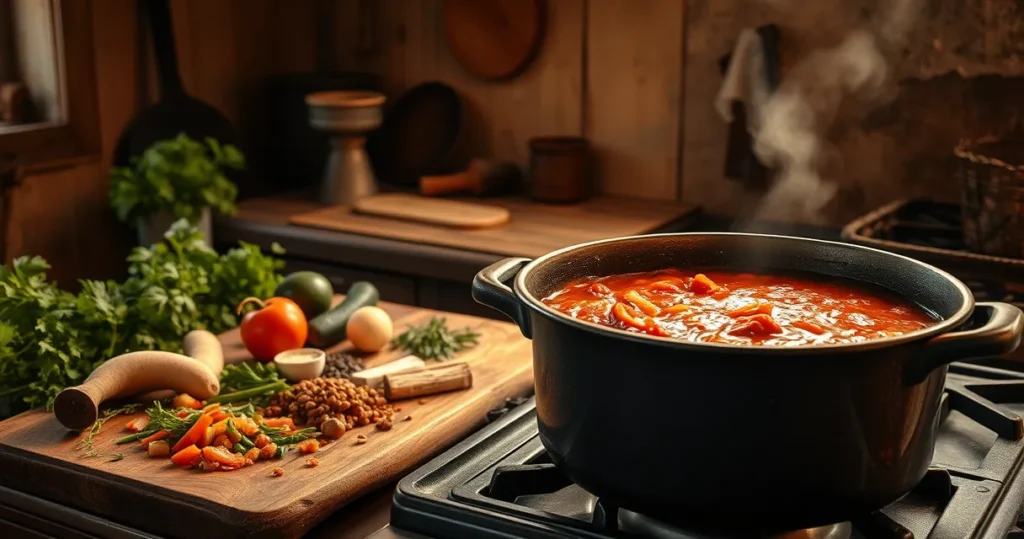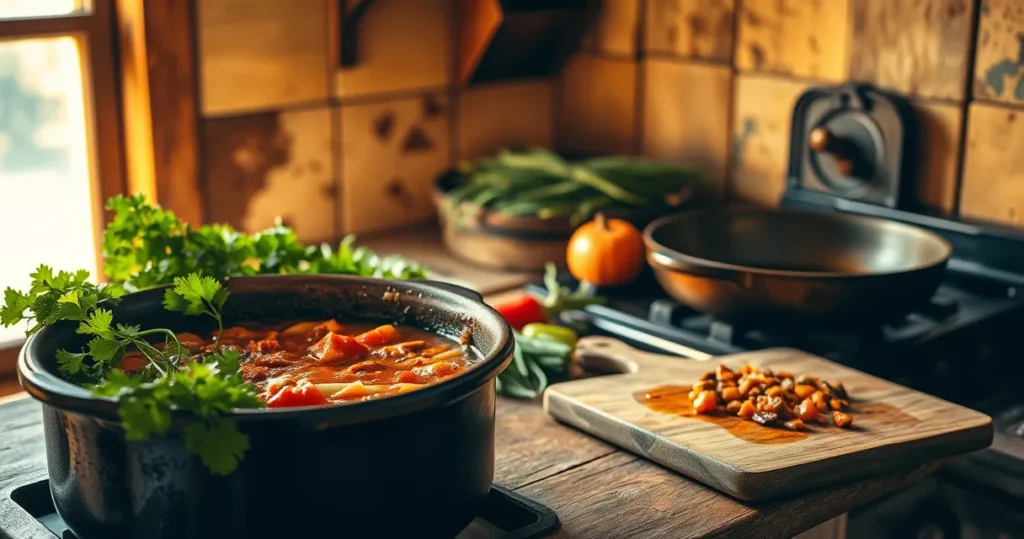Table of Contents
Discover the essence of Louisiana cuisine with a true Cajun chicken stew. It not only warms your heart but also tickles your taste buds. This dish is more than a meal; it’s a journey into the heart of southern cooking traditions.
The Cajun chicken stew is packed with bold flavors and hearty ingredients. It turns simple ingredients into a special dining experience. Every bite shares stories of Louisiana’s cooking heritage passed down through generations.
This dish takes about 2 hours to make, serving 6 generous portions. Its deep brown roux and seasoned chicken capture the spirit of Louisiana cuisine.
Key Takeaways
- Traditional Louisiana comfort food with deep cultural roots
- Rich, complex flavors developed through careful cooking techniques
- Nutritious meal with high protein content (63g per serving)
- Authentic recipe requiring approximately 2 hours of preparation
- Versatile dish perfect for family gatherings
The Rich Heritage of Louisiana Stew Cooking
Cajun cooking history is a vibrant tapestry woven with cultural resilience and culinary creativity. The roots of Louisiana food culture run deep, tracing back to the French Acadian settlers. They transformed their traditional cooking methods to suit the local ingredients and landscape.

Traditional stew recipes emerged from a blend of survival skills and cultural adaptation. Cajun cuisine developed in the southwestern regions of Louisiana. Resourceful cooks learned to create delicious meals from available ingredients.
Origins of Cajun Cuisine
The story of Cajun cooking begins with French settlers expelled from Acadia (modern-day Nova Scotia) in the 18th century. These resilient people brought their cooking techniques to Louisiana. They adapted them to the new environment:
- Utilized local ingredients like crawfish and game meats
- Developed one-pot cooking methods
- Created distinctive flavor profiles using local spices
Traditional Cooking Methods
Cajun cooks perfected unique cooking techniques that became hallmarks of their culinary tradition. Cast iron skillets and Dutch ovens were essential tools. They helped develop deep, rich flavors in their dishes.
- Slow-cooking techniques
- Developing complex roux bases
- Using the “holy trinity” of vegetables (onions, celery, bell peppers)
Cultural Significance
More than just a way of cooking, Cajun cuisine represents a profound connection to heritage. Each traditional stew recipe tells a story of survival, community, and the remarkable ability to transform simple ingredients into extraordinary meals.
The legacy of Cajun cooking continues to inspire chefs and home cooks. It preserves a rich culinary tradition that celebrates resilience and creativity.
Essential Ingredients for Authentic Cajun Chicken Stew

To make a real Cajun chicken stew, you need the right ingredients. Boneless chicken thighs are at the core, adding rich taste and tender texture. They soak up the bold Cajun spices, giving the stew its unique flavor.
The Holy Trinity of Cajun cooking is key to the stew’s flavor. This mix includes:
- Onions
- Celery
- Green bell peppers
Your Cajun spice blend is also vital. For the best taste, mix:
- 1 tablespoon garlic powder
- 2 teaspoons onion powder
- 1 teaspoon dried paprika
- 1/2 teaspoon cayenne pepper
- Dried parsley flakes
When preparing chicken thighs, cut them into small pieces. This ensures even cooking and better flavor absorption. The secret to a great Cajun chicken stew is in choosing and mixing these key ingredients. Each one adds to the dish’s harmony and taste.
Pro tip: Chop your veggies the night before. It makes cooking easier and lets the flavors blend perfectly. Your taste buds will appreciate the effort!
Understanding the Holy Trinity of Cajun Cooking
Cajun cuisine is known for its unique taste. At its heart is the Cajun Holy Trinity. This mix of vegetables makes simple dishes into amazing meals.
The Holy Trinity includes onions, celery, and bell peppers. These ingredients come from Louisiana’s rich food history. Chef Paul Prudhomme made them famous. They are used in equal parts to create a base for many dishes.
Perfect Vegetable Proportions
Chefs use a specific ratio when making the Holy Trinity:
- 1 part onions
- 1 part celery
- 1 part green bell peppers
Some chefs tweak the recipe a bit. They might use 2 cups of onion, 1½ cups of celery, and 1¼ cups of green pepper. This lets them add their own touch while keeping the flavor true.
Proper Preparation Techniques
To get the most flavor, sauté the Holy Trinity with care. Use 2 tablespoons of unsalted butter over medium heat for about 10 minutes. The aim is to soften the veggies without browning them, keeping their flavors bright.
Impact on Flavor Development
The Holy Trinity is more than just a mix of veggies. It’s a flavor base that adds depth to Cajun dishes. Whether it’s gumbo or jambalaya, these ingredients make simple recipes into culinary wonders.
Mastering the Perfect Cajun Roux
Making the perfect dark roux is key to authentic Cajun cooking. It turns simple flour and oil into a flavor-rich base for chicken stew. This process needs patience, focus, and a gentle touch.
It’s important to understand how to make roux. Start with equal parts flour and oil in a heavy skillet. Stir constantly and keep the heat low.
- White roux: Light and takes 2-5 minutes
- Blond roux: Develops in 5-10 minutes
- Brown roux: Requires 15-30 minutes
- Dark roux: Takes 30-45 minutes to reach chocolate color
The roux’s transformation is a dance of color and flavor. Stirring reveals changes from pale to a rich, nutty smell. Use vegetable oil for its high smoke point and neutral taste.
Pro tip: Watch your roux closely. It can burn quickly. Keep the heat low and stir constantly. Aim for a deep, chocolate-brown color with a rich smell.
A great dark roux is more than thickening. It’s the heart of your Cajun chicken stew, adding depth and character to each bite.
Choosing the Right Chicken Cuts for Your Stew
When making a Cajun chicken stew, picking the right chicken cut is key. Dark meat, like chicken thighs, is the best choice. It makes the stew rich and tender.
Benefits of Dark Meat
Chicken thighs are special for your stew. They are more flavorful and can handle long cooking times well. They stay tender and juicy, even after hours of simmering.
- Take less than 15 minutes to become tender
- Retain moisture better than white meat
- Absorb seasonings more effectively
- Provide a richer, more robust flavor profile
Size and Portion Guidelines
When preparing chicken thighs for your stew, keep these tips in mind. Cut them into even pieces for even cooking. Aim for pieces about 1-inch thick, so they fit well with other stew ingredients.
Preparation Tips
To make your chicken stew better, trim off any extra fat first. This keeps the stew from getting too thick. You want the chicken pieces to cook evenly and soak up the Cajun seasonings well.
- Trim excess fat from chicken thighs
- Cut into consistent 1-inch pieces
- Remove any visible connective tissue
- Pat chicken dry before seasoning
Choosing dark meat and following these tips will make your Cajun chicken stew delicious. It’s sure to impress your dinner guests.
Step-by-Step Cajun Chicken Stew Recipe
Ready to make a Cajun stew that takes you to Louisiana? This easy one-pot meal is perfect for family dinners. It requires little prep work.
Ingredients Needed
- 2 pounds bone-in chicken pieces
- 1 tablespoon Cajun seasoning
- 2 tablespoons extra virgin olive oil
- 1 diced onion
- 4 stalks diced celery
- 1 diced bell pepper
- 3 minced garlic cloves
Start by seasoning your chicken with Cajun seasoning. Heat olive oil in a big Dutch oven. Brown the chicken until it’s golden. Then, take the chicken out and set it aside.
Cooking Instructions
- Sauté the vegetable trinity (onion, celery, bell pepper) until soft
- Add minced garlic and cook for 1 minute
- Stir in 2 tablespoons tomato paste
- Return chicken to the pot
- Pour in 2 cups chicken broth
- Add bay leaves and Worcestershire sauce
Cover and simmer for 35-45 minutes at 400°F. You’ll get a rich Cajun chicken stew. It serves 4-6 people, with about 492 calories per serving.
Pro tip: Serve over steamed rice for an authentic Louisiana dining experience!
Tips for Achieving Authentic Cajun Flavors
To make a great Cajun chicken stew, it’s not just about following a recipe. It’s about mastering the art of flavor. This includes careful seasoning, slow cooking, and keeping the right temperature.
Getting the Cajun seasoning right is key to true Louisiana taste. Your spice mix should have just the right amount of heat and depth. Here are some tips:
- Use fresh Cajun seasoning with a mix of cayenne, paprika, garlic powder, and black pepper
- Layer spices throughout the cooking process for complex flavor development
- Adjust heat levels by controlling cayenne and red pepper flakes
Seasoning Balance
The secret to great flavor is knowing how spices work together. Taste as you go and adjust your Cajun seasoning as needed. Start with a little cayenne, as it can quickly take over.
Cooking Time Considerations
Slow cooking is essential for rich, deep flavors in your stew. Let it simmer for 1.5-2 hours. The longer it cooks, the better it tastes.
Temperature Control
Keeping the right temperature is important to avoid burning and get the best flavors. Keep it at a gentle simmer, stirring now and then. This way, you prevent scorching and get that authentic Cajun taste.
Serving Suggestions and Accompaniments
Enhance your Cajun meal with the right rice pairings and side dishes. These choices bring out the best in your chicken stew. They make your meal balanced and fulfilling.
Rice is a classic choice for Cajun chicken stew. Here are some tasty options:
- Fluffy white long-grain rice
- Dirty rice with celery, bell pepper, and onion
- Jasmine rice for a fragrant twist
For a complete Cajun meal, try these side dishes:
- Crisp coleslaw with a creamy texture
- Cornbread with jalapeño and cheddar
- Southern-style baked beans
- Fried okra
- Hush puppies
If you want something lighter, a zesty green salad or pickled veggies are great. They offer a refreshing contrast to the stew’s bold flavors. The goal is to balance the spicy and rich with fresh, crisp sides.
Prep times vary for these sides. You can have roasted potatoes in 10 minutes or Southern baked beans in 45 minutes. Pick sides that fit your schedule and keep the Cajun meal spirit alive.
Conclusion
Your homemade Cajun stew is more than a meal. It’s a journey through Louisiana’s rich food history. Every spoonful connects you to generations of cooks who loved and perfected this recipe.
Mastering this Cajun chicken stew is not just about dinner. It’s about keeping a cultural tradition alive. It turns simple ingredients into a satisfying experience. The flavors tell a story of resilience, creativity, and community in Louisiana cooking.
Sharing this stew with loved ones brings people together. It creates lasting memories at your dinner table. Whether you’re experienced or new to cooking, this recipe opens the door to Cajun cuisine. Your kitchen becomes a place of warmth and celebration of a special food tradition.
Cooking is an art form. Every time you make this stew, you’ll get better and appreciate Louisiana’s flavors more. Enjoy the process, the aromas, and every bite of your creation.
FAQ
What makes Cajun chicken stew different from other chicken stews?
Cajun chicken stew stands out with its rich brown roux and the Holy Trinity (onions, celery, and bell peppers). It also has a unique blend of Cajun spices. These elements create a deep, complex flavor that’s unique to Louisiana cuisine.
Why do Cajun recipes typically use chicken thighs instead of breast meat?
Chicken thighs are chosen for their extra fat and flavor. They stay tender and moist during long cooking times. This is key for an authentic and delicious Cajun chicken stew.
How important is the roux in Cajun chicken stew?
The roux is very important in Cajun cooking. It thickens the stew and adds a deep, nutty flavor. This gives the dish its rich and complex taste.
What is the Holy Trinity in Cajun cooking?
The Holy Trinity includes finely chopped onions, celery, and bell peppers. These vegetables are essential in Cajun cuisine. They provide a flavor base for many traditional Louisiana dishes.
Can I make Cajun chicken stew spicy or mild?
Yes, you can adjust the spice level. You can add more Cajun seasoning, cayenne pepper, or hot sauce. This lets you customize the heat to your liking.
What are the best side dishes to serve with Cajun chicken stew?
Serve it with white rice, cornbread, or crusty French bread. For a balanced meal, add a crisp green salad or pickled vegetables. They help balance the stew’s richness.
How long does Cajun chicken stew typically take to prepare?
It takes about 1.5 to 2 hours to prepare. This time allows for the flavors to develop and the chicken to become tender. It’s infused with rich Cajun spices.
Is Cajun chicken stew a good make-ahead meal?
Yes, it tastes better the next day. The flavors meld and develop. It’s great for meal prep and can be stored in the fridge and reheated.
What type of pot is best for making Cajun chicken stew?
A cast-iron Dutch oven is best. It distributes heat evenly and enhances the deep flavors of authentic Cajun cooking.
Can I substitute ingredients in the recipe?
You can make some substitutions, but stick to the core ingredients. The Holy Trinity and key spices are essential for the authentic Cajun flavor.








